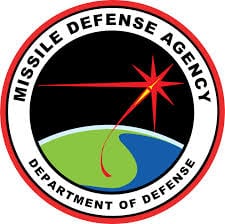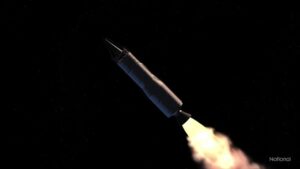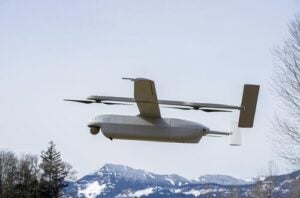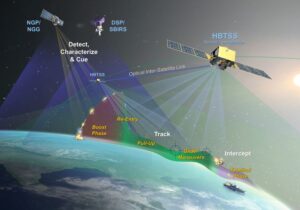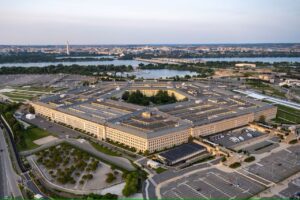
By Will Hurd, Defense Opinion Writer.
The Trump administration’s proposed “Golden Dome” missile defense initiative could revolutionize homeland defense.
But the debate around it is overlooking a critical point. The most immediate threats to the nation will come not from enemy missiles that are launched into space and then arc down toward us. They will come from the “underlayer” — the low-altitude area where traditional radar coverage is weakest and terrain masking allows adversaries to approach undetected.
Done right, Golden Dome isn’t just about intercepting enemy weapons. It’s also about modernizing the civilian systems that millions of Americans rely on every day to fly safely. The same investment can close our biggest military blind spot and upgrade the Federal Aviation Administration’s (FAA) aging infrastructure.
The overlooked underlayer
U.S. missile defense has long been structured around protecting from intercontinental ballistic missiles (ICBMs) reentering the atmosphere from space. But today’s adversaries are innovating entirely different technologies.
The threat is not theoretical. Israel’s Operation Rising Lion against Iran’s nuclear facilities used drones deep inside Iran. Ukraine’s Operation Spiderweb snuck autonomous aircraft into Russia to carry out attacks against military jets. Military analysts will be dissecting these operations for years, and Chinese strategists have already noted how similar attacks “could be employed in the Taiwan Strait.” These tactics require modest technology and modest budgets compared to ICBMs.
Our enemies no longer need nuclear missiles to wreak havoc on our soil. A van outfitted with drones could threaten the power grid, a container ship in the Gulf of Mexico could launch cruise missiles at ports, or aircraft operating 500 miles off California could target our military bases. The capability exists. The question is whether we can see it in time.
That same blind spot creates risks in peacetime, as our skies grow more crowded with drones, delivery aircraft and passenger planes. The underlayer is where America is blind—whether to adversaries or to accidents waiting to happen.
Lessons from experience
As a CIA officer in Afghanistan and Pakistan, I watched terrorists constantly adapt to bypass our defenses. Later, in Congress, representing communities along hundreds of miles of the border with Mexico, I saw narcotraffickers—and nation states—get equally creative at infiltrating our country. The same ingenuity is shaping how our adversaries think about penetrating U.S. airspace.
The Golden Dome must continue to address sophisticated attacks like hypersonics and ICBMs from outside the atmosphere. But it must also defend against subsonic weapons such as cruise missiles, advanced fighters and unconventional platforms like drones launched from the underlayer.
In the movie “Top Gun: Maverick,” pilots “flew under the radar” by hugging the terrain to avoid detection. Hollywood dramatization aside, the vulnerability is real. To counter these underlayer threats and see what legacy systems cannot, we need advanced digital radars and distributed sensor networks that function as an interconnected system rather than isolated units. Those same radars can also help air traffic controllers manage crowded skies.
Protecting all that matters
Golden Dome’s architecture should cast protective coverage over our most critical vulnerabilities—not just guard against ICBMs. That means shielding high-value targets like power infrastructure, ports and airports.
The federal government has long acknowledged that disruption of the transportation sector—including the nation’s 500-plus commercial airports—would have a “debilitating effect” on security and the economy. Since 2021, The Department of Homeland Security has tracked more than 3,000 drone incidents near airports, with 11 aircraft this year alone forced into evasive maneuvers.
While our enemies are trying to exploit coverage gaps, delivery drones and private aircraft are filling our skies. The line between homeland defense and aviation safety is vanishing. Investments that solve one must solve both.
Moving forward
Critics argue that space-based systems are too expensive and that aviation is already safe enough. But the distributed Golden Dome approach, focused on the underlayer, addresses both concerns. By leveraging terrestrial radar networks that serve dual military and civilian purposes, we achieve homeland defense at a fraction of traditional costs while improving aviation safety for millions of Americans.
Golden Domes aren’t just missile shields. They’re a smarter way to protect Americans at home, whether from hostile drones or crowded skies. If we don’t build layered defense now, our blind spot will become the bullseye.
Will Hurd, a former CIA officer and U.S. representative from Texas, is chief strategy officer at Los Angeles-based CHAOS Industries.

Are you a Defense Daily reader with a thought-provoking opinion on a defense issue? We want to hear from you.
- We welcome submissions of opinion articles on national security, defense spending, weapons systems and related areas.
- We welcome submissions from lawmakers, administration officials, industry representatives, military officials, academics, think tank experts, congressional candidates, international experts and others on issues important to the national defense community.
- We welcome a diverse range of opinions all along the political spectrum.
- Email: editor@DefenseOpinion.com





